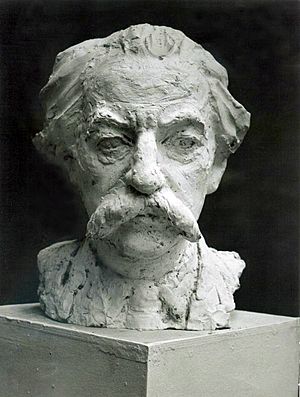Juri Lotman facts for kids
Quick facts for kids
Juri Lotman
|
|
|---|---|

Bust of Juri Lotman by Lev Razumovsky, 1980
|
|
| Born | 28 February 1922 |
| Died | 28 October 1993 (aged 71) |
| Education | Leningrad State University |
| Era | 20th-century philosophy |
| Region | Western philosophy |
| School | Tartu–Moscow Semiotic School |
| Institutions | University of Tartu |
|
Main interests
|
Semiotics |
Juri Lotman (Russian: Ю́рий Миха́йлович Ло́тман; 28 February 1922 – 28 October 1993) was a prominent Russian-Estonian literary scholar, semiotician, and historian of Russian culture, who worked at the University of Tartu. He was elected a member of the British Academy (1977), Norwegian Academy of Science and Letters (1987), Royal Swedish Academy of Sciences (1989) and Estonian Academy of Sciences (1990). He was a founder of the Tartu–Moscow Semiotic School. The number of his printed works exceeds 800 titles. His archive (which is now kept at the University of Tallinn and at the Tartu University Library) which includes his correspondence with a number of Russian and Western intellectuals, is immense.
Biography
Juri Lotman was born in the Jewish intellectual family of lawyer Mikhail Lotman and Sorbonne-educated dentist Aleksandra Lotman in Petrograd, Russia. His elder sister Inna Obraztsova graduated from Leningrad Conservatory and became a composer and lecturer of musical theory, his younger sister Victoria Lotman was a prominent cardiologist, and his third sister Lidia Lotman was a scholar of Russian literature of the second half of the 19th century on staff at the Institute for Russian Literature of the Russian Academy of Science (Pushkin House) (she lived in Saint-Petersburg).
Lotman graduated from the secondary school in 1939 with excellent marks and was admitted to Leningrad State University without having to pass any exams. There he studied philology, which was a choice he made due to Lidia Lotman's university friends (actually he attended university lectures in philology whilst he was still at secondary school). His professors at university were the renowned lecturers and academicians – Gukovsky, Azadovsky, Tomashevsky and Propp. He was drafted in 1940 and during World War II served as a radio operator in the artillery. Demobilized from the army in 1946, he returned to his studies in the university and received his diploma with distinction in 1950. His first published research papers focused on Russian literary and social thought of the 18th and 19th century.
Unable to find an academic position in Leningrad due to anti-Semitism (he was unable to apply for a PhD program), Lotman went to Estonia in 1950 and from 1954 began his work as a lecturer in the Department of Russian literature of Tartu University and later became head of the department.
In the early '60s Lotman established academic contacts with a group of structuralist linguists in Moscow, and invited them in the first Summer School on Secondary Modeling Systems, that took place in Kääriku from 19th to 29 August 1964. The group gathered at the first summer school later developed into what is now known as the Tartu–Moscow Semiotic School. Among participants of the summer school, and later members of the Tartu–Moscow school, were such names as Boris Uspensky, Vyacheslav Ivanov, Vladimir Toporov, Mikhail Gasparov, Alexander Piatigorsky, Isaak I. Revzin and Georgii Lesskis. As a result of their collective work, they established a theoretical framework for the study of the semiotics of culture.
This school has been widely known for its journal Sign Systems Studies, published by Tartu University Press ("Труды по знаковым системам") and currently the oldest semiotics journal in the world (established in 1964). Lotman studied the theory of culture, Russian literature, history, semiotics and semiology (general theories of signs and sign systems), semiotics of cinema, arts, literature, robotics, etc. In these fields, Lotman has been one of the most widely cited authors. His major study in Russian literature was dedicated to Pushkin; among his most influential works in semiotics and structuralism are Semiotics of Cinema, Analysis of the Poetic Text and The Structure of the Artistic Text. In 1984, Lotman coined the term semiosphere. In 1991 he received the Gold Medal of Philology, the highest award for a philological scholar.
Juri Lotman's wife Zara Mints was also a well-known scholar of Russian literature and Tartu professor. They have three sons:
- Mihhail Lotman (born 1952) is professor of semiotics and literary theory at Tartu University, is active in politics and has served as a member of the Riigikogu (Estonian Parliament) as a member of the conservative Res Publica Party.
- Grigori Lotman (born 1953) is an artist.
- Aleksei Lotman (born 1960) is a biologist, since 2006 he has also been a politician and a member of parliament for the Estonian Greens party (2007–2011).
See also
 In Spanish: Yuri Lotman para niños
In Spanish: Yuri Lotman para niños
- Philosophy in the Soviet Union
- Semiotics
- Literary formalism
- Semiosphere

